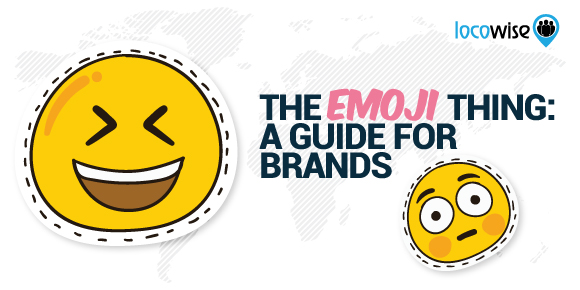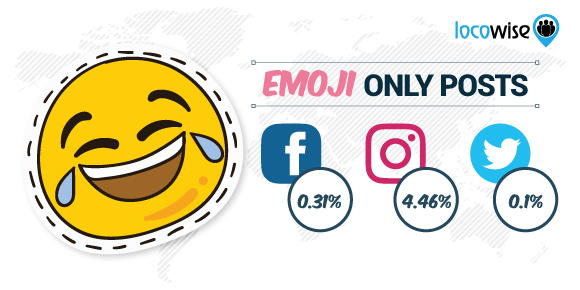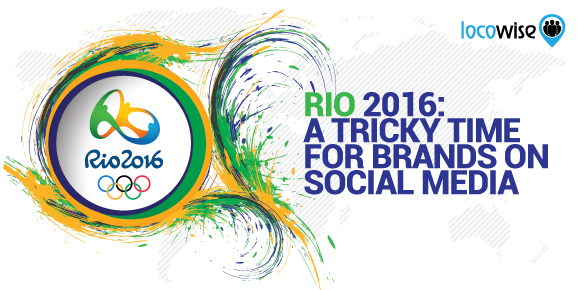The Emoji Thing: A Guide For Brands
Sahail Ashraf posted on 24 August 2016
Sometimes it’s hard to imagine a world without emojis. The cute and instantly expressive icons have pretty much taken over the Internet, and have absolutely dominated messaging. This is because they are easy to use and understand, and they have that immediate impact.
We have seen emojis really take off on social media. Locowise now includes emojis as part of our sentiment analysis. It may even be the case that emojis help with brand engagement.
We thought we could take a look at emojis as a topic and see how they may be being used by brands. Is there a purposeful approach from brands on social media, or are they just pretty faces?

So, what are they?
They are faces, mostly. In fact, some of the most popular emojis are icons of smiley faces, or laughing faces. You can also have emojis of unicorns, and some emojis are even downright rude. Basically a set of icons that are used to convey a message.
People have been using emojis for some time now. But they’ve only just started to boost engagement on social media.
That’s right. Emojis can be used on your social media platforms to boost engagement. There is perhaps one clear reason for this. Think about the amount of posts you see on Facebook or tweets on Twitter, and the majority of them consist of text (along with a photo or video). It can be a lot to wade through, and can turn people off.
Stick some emojis in there and you have a whole new ballgame. A tweet, for example, with some text in it will receive a more positive reaction if it has an emoji or two sprinkled through it. Some people have been known to just tweet a single emoji, as it happens. In our research we found that 4.46% of all posts on Instagram are emoji-only, while on Faceook it’s 0.31% and on Twitter it’s 0.1%.

Looking at it another way, there isn’t much space in the form of a tweet, or a status update. You may get just a few words or characters, and you certainly can’t elaborate too much on your topic in the social media space (we’re ignoring blogging while making this point). People process visual images (and the messages or emotions they convey) much faster than they do the written word. So careful and appropriate use of emojis will have a real impact on your audience.
And which emojis are the best?
There’s no real ‘best’ emoji out there because, when you think about it, every use of an emoji can only really succeed if the context is right. If you are conveying some rather serious news on your Twitter feed, a laughing face probably won’t work.
But that said, there are certain emojis that are simply popular. Needless to say, with social media predominately being a happy and positive space to be for brands (you don’t see too many brands moaning about the weather on Twitter), the corresponding most popular emojis are of a happy variety.
According to our own research, on Facebook we found that 16.73% of the time emojis were used the emoji chosen was the ‘face with tears of joy’. On Twitter, the picture was nearly the same, with ‘face with tears of joy’ still being top, but with 6.67% of the share.
On Instagram, the story was slightly different, with ‘tears of joy’ being shunted down to third position. Top of the list was ‘smiling face with heart-shaped eyes’, with a respectable 8.45%.
Instagram seems to be the most emoji friendly of social media platforms. From comments we looked at 69% of all emojis were used on Instagram, 15.6% on Twitter and 15.4% on Facebook. The 50 most used emojis account for 78% of all used emojis.

Here are the full numbers from our research where we looked at a sample of one million comments on each of the main platforms:
| TOP 10 emojis on Facebook | ||
|---|---|---|
| 16.73 % | ? | Face with tears of joy |
| 4.61 % | ? | Smiling face with heart-shaped eyes |
| 3.92 % | ❤ | Heavy black heart |
| 3.22 % | ? | Thumbs up sign |
| 2.09 % | ? | Smiling face with smiling eyes |
| 1.68 % | ? | Face throwing a kiss |
| 1.65 % | ? | Clapping hands sign |
| 1.43 % | ? | Grinning face with smiling eyes |
| 1.39 % | ? | Pouting face |
| 1.31 % | ? | Winking face |
| TOP 10 emojis on Instagram | ||
|---|---|---|
| 8.45 % | ? | Smiling face with heart-shaped eyes |
| 8.03 % | ? | Fire |
| 7.11 % | ? | Face with tears of joy |
| 6.51 % | ? | Police cars revolving light |
| 4.75 % | ⬇ | Downwards black arrow |
| 4.22 % | ❤ | Heavy black heart |
| 2.91 % | ? | Large red circle |
| 1.95 % | ? | Thumbs up sign |
| 1.79 % | ? | Face throwing a kiss |
| 1.61 % | ? | Face screaming in fear |
| TOP 10 emojis on Twitter (last million comments) | ||
|---|---|---|
| 6.67 % | ? | Face with tears of joy |
| 5.08 % | ⚽ | Soccer ball |
| 4.33 % | ❤ | Heavy black heart |
| 3.89 % | ? | Smiling face with heart-shaped eyes |
| 2.88 % | ? | Fire |
| 2.67 % | ? | Clapping hands sign |
| 2.06 % | ?? | Regional indicator symbol letter us |
| 1.96 % | ? | Person raising both hands in celebration |
| 1.88 % | ? | Flexed biceps |
| 1.83 % | ? | Movie camera |
How brands are using emojis
There are some excellent examples of brands using emojis, and we will take a look at a couple here. But bear in mind that, as we hinted earlier, context is key. While your audience will probably react positively to an emoji, if it doesn’t make sense to have it there, it will just look stupid, and possibly even desperate.
The best example we have seen of ‘making sense to have it there’ comes from Domino’s Pizza. These guys are no slouch when it comes to high quality work on social media, but the recent work they have come up with using emojis is a major leap forward.
Remember when we said that a good emoji can take the place of a waste of words? Well, Dominos knew this when they created an opportunity for customers to order a pizza using the famous ‘pepperoni slice’ emoji. This particular emoji has been around for some time, and in an inspired move, Dominos set up a situation where, once registered, all customers had to do was tweet that simple single emoji. This then meant a pizza order, which was later confirmed by direct message. Simple and easy, and it showed just how emojis can make communication happen at lightning speed.
It’s as simple as this. Amazing stuff when you think about it.
Coca-Cola, always a trendsetter when it comes to social media, got its hands on the world’s first paid emoji opportunity when it worked with Twitter to create a ‘share a Coke’ emoji. If you type in #shareacoke when tweeting, the emoji of two bottles clinking together comes up. That’s right, the drinks giant has its own emoji.
It wasn’t just for kudos either. The emoji was so successful it became the basis of a huge amount of attention on Twitter, with over 170,000 mentions so far.
How to do it for your brand
It has been suggested by some figures in social media that emojis boost engagement. We know it does for companies like Coca-Cola, but would it work for a smaller company, a mid-sized brand, for example?
Well, it’s hard to see how emojis could hurt a brand, unless the brand used them carelessly or excessively. As mentioned earlier, the tears of joy face is universally popular on social, but it doesn’t mean it will work for your brand. It has to fit.
We suggest testing the waters, and running a few tweets or updates that have emojis in them. See what drives engagement. If the emoji tweet, for example, brings more engagement than the tweet without an emoji, you’re probably onto something.

From what we can see, old-school social media rules still apply. Coca-Cola are currently running tweets around Rio 2016, with a wonderfully cute little emoji at the end of them. These tweets are building a healthy set of likes and retweets, but not necessarily seeing anymore than other, older tweets. It all seems relative.
We think smaller brands have most to gain from emojis. Keep them sensible and contextual, and you have every reason to expect more engagement. Remember the visual quality too. If something can be said with a small picture rather than a drawn out tweet, we know what we would do.




